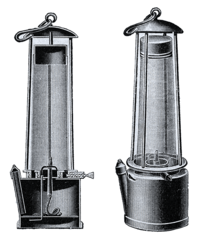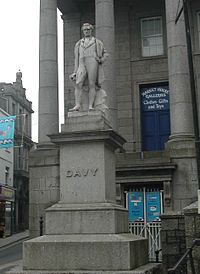User:Pigmint/sandbox
Davy lamp[edit]


After his return to England in 1815, Davy began experimenting with lamps that could be used safely in coal mines. The Revd Dr Robert Gray of Bishopwearmouth in Sunderland, founder of the Society for Preventing Accidents in Coalmines, had written to Davy suggesting that he might use his 'extensive stores of chemical knowledge' to address the issue of mining explosions caused by firedamp, or methane mixed with oxygen, which was often ignited by the open flames of the lamps then used by miners. Incidents such as the Felling mine disaster of 1812 near Newcastle, in which 92 men were killed, not only caused great loss of life among miners but also meant that their widows and children had to be supported by the public purse. The Revd Gray and a fellow clergyman also working in a north-east mining area, the Revd John Hodgson of Jarrow, were keen that action should be taken to improve underground lighting and especially the lamps used by miners. [1]
[developing the lamp:] [original] Davy conceived of using an iron gauze to enclose a lamp's flame, and so prevent the methane burning inside the lamp from passing out to the general atmosphere.
[notes: davy works out that methane emitted from the coal mixed with air (oxygen?) and when exposed to high temperatures (from the miner's lamps?) caused the mixture of gases to explode.So devised a lamp that allowed the methane/air mixture to remain cool when coming in contact with the lamp - the gases entered and left the lamp through narrow tubes that had a cooling effect. Next he made sure that the flame was enclosed inside a wire gauze cylinder. This had a dual purpose: it could detect firedamp, and the lamp would only explode if it became extremely hot.
[controversy:]
Stephenson had devised a similar lamp at about the same time, and davy disputed his claim to be the inventor of a safe lamp
[original:] Although the idea of the safety lamp had already been demonstrated by William Reid Clanny and by the then unknown (but later very famous) engineer George Stephenson, Davy's use of wire gauze to prevent the spread of flame was used by many other inventors in their later designs. George Stephenson's lamp was very popular in the north-east coalfields, and used the same principle of preventing the flame reaching the general atmosphere, but by different means.[2] Unfortunately, although the new design of gauze lamp initially did seem to offer protection, it gave much less light, and quickly deteriorated in the wet conditions of most pits. Rusting of the gauze quickly made the lamp unsafe, and the number of deaths from firedamp explosions rose yet further.
There was some discussion as to whether Davy had discovered the principles behind his lamp without the help of the work of Smithson Tennant, but it was generally agreed that the work of both men had been independent. Davy refused to patent the lamp, and its invention led to his being awarded the Rumford medal in 1816.[3]
- ^ Knight, David (1992). Humphry Davy: Science and Power. Cambridge, UK: Cambridge University Press, pp. 105-6. ISBN 0-631-16816-8.
- ^ Holmes 2008, pp. 364–373.
- ^ David Knight (2004) "Davy, Sir Humphry, baronet (1778–1829)" in Oxford Dictionary of National Biography, Oxford University Press

